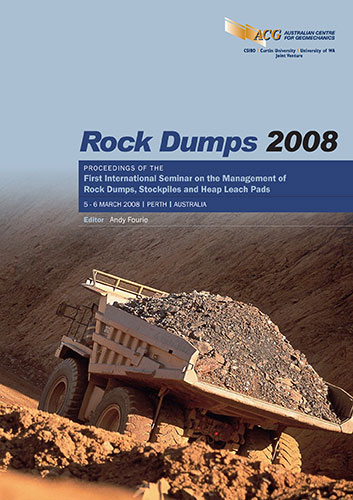Geotechnical Aspects of the Hydro-Jex Operation

|
Authors: Ulrich, BF |
DOI https://doi.org/10.36487/ACG_repo/802_4
Cite As:
Ulrich, BF 2008, 'Geotechnical Aspects of the Hydro-Jex Operation', in AB Fourie (ed.), Rock Dumps 2008: Proceedings of the First International Seminar on the Management of Rock Dumps, Stockpiles and Heap Leach Pads, Australian Centre for Geomechanics, Perth, pp. 47-55, https://doi.org/10.36487/ACG_repo/802_4
Abstract:
Many heap leach operations are very large, covering many hectares and containing millions of tonnes of low-grade ore. Operators estimate recovery from laboratory column tests on ore samples that typically produce metal values somewhat lower than the column leach tests with the resultant metal inventory remaining in the heaps. After the ore material is placed and ripped, the only operational technique to improve recovery revolves around solution and reagent management. The key to reducing metal values in the heap inventory is to promote the contact of the leaching lixiviant to the valuable mineral and then to rinse the dissolved metal from the ore. This is normally accomplished by applying additional solution to the surface of the leach pads in a two dimensional fashion via emitters and sprinklers. Hydro Jex, a proprietary metallurgical technique, was developed to take heap leaching into three dimensions, a new concept for the metals extractive industry. This technology has been used by Newmont Mining Corporation on gold heap leach pads on the Carlin Trend in Nevada for the last three years to recover the inventory gold remaining in heaps after traditional solution application. It is the nature of Hydro-Jex to deliver significant amounts of solution, in a controlled manner, to discrete areas within a heap. As a consequence, the resulting pore pressures an elevated phreatic surface could have a considerable and adverse influence on the slope stability of a heap. It is therefore vital that the possible effects of the Hydro- Jex operation on slope stability be thoughtfully investigated prior to its implementation. Such investigation and analytical processes are presented herein and preliminary advice pertaining to slope stability is provided.
References:
Seal, T. (2007) Hydro-Jex: Heap Leach Pad Stimulation Technology; Ready for World Wide Industrial Adoption? SME
Annual Meeting, Denver, Colorado, 25-28 February, Preprint, pp. 7-123.
XSTABL, Interactive Software Designs, Inc, 953 N. Cleveland Street, Moscow, ID 83843, U.S.A.
Geotechnical Issues – Strength, Stability and Seepage
Rock Dumps 2008, Perth, Australia 55
© Copyright 2025, Australian Centre for Geomechanics (ACG), The University of Western Australia. All rights reserved.
View copyright/legal information
Please direct any queries or error reports to repository-acg@uwa.edu.au
View copyright/legal information
Please direct any queries or error reports to repository-acg@uwa.edu.au